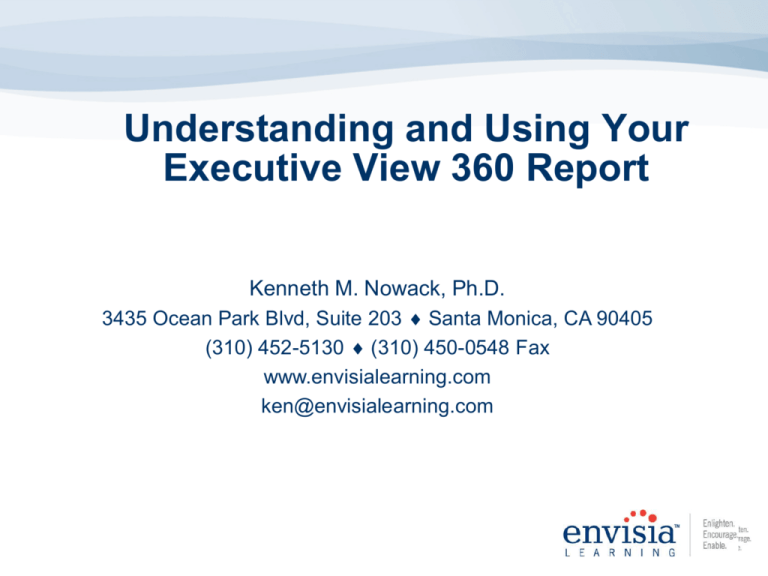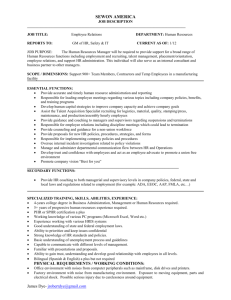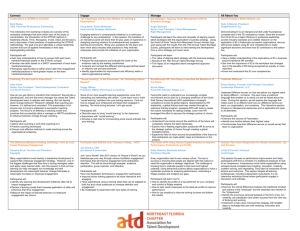Executive View 360
advertisement

Understanding and Using Your Executive View 360 Report Kenneth M. Nowack, Ph.D. 3435 Ocean Park Blvd, Suite 203 Santa Monica, CA 90405 (310) 452-5130 (310) 450-0548 Fax www.envisialearning.com ken@envisialearning.com Presentation Agenda Executive View Online Process Understanding and Using Your Executive View 360 to Develop Leadership Talent Translating Awareness into Behavior Change: An Introduction to Talent Accelerator Next Steps/Questions Executive View 360 Online Process Executive View 360 Email Invite Presentation Agenda Understanding and Using Your Executive View 360 to Develop Leadership Talent Translating Awareness into Behavior Change: An Introduction to Talent Accelerator Next Steps/Questions Emotional Reactions to Feedback: GRASP Model Grin or Grimace Recognize or Reject Act or Accept Strategize & Partner Emotional Reaction Cognitive Reaction Commitment Reaction Behavioral Reaction Interpreting Your Executive View 360 Feedback Report Interpreting Your Emotional Intelligence View 360 Feedback Report ExecutiveView360 Performance Leadership Visionary Leadership Drive for Results Technological Leadership Financial Leadership Cross Functional Versatility Depth of Industry Knowledge Political Leadership Strategic Problem Analysis Decision Making Change Leadership Entrepreneurial Leadership Driving Strategic Direction Driving Change Interpersonal Leadership Build Strategic Relationships Empowering Others Team Building Interpersonal Effectiveness Oral Communication/Presentation Influence/Negotiation Coaching/Talent Development Personal Leadership Self-Development Adaptability/Flexibility Engenders Trust Executive View 360 Features Measures 22 Competencies Focusing on Performance Leadership, Change Leadership, Interpersonal Leadership and Intrapersonal Leadership 68 Behavioral Questions Online Administration Reliable and Valid Scales Comprehensive Summary Feedback Report Executive View 360 Report Executive View 360 (EV360) Competency Definitions and Conceptual Model Self-Awareness/Social Awareness Comparison Graphs EV360 Overall Competency Graphs (self and other comparisons) Most Frequent/Least Frequent Behavior Summary Summary of Average Scores by Rater Category with Statistical Measure of Rater Agreement Written Comments by Raters Developmental Action Plan Confidentiality of the 360 Feedback Process KEY POINTS All raters are anonymous except for the “manager” Online administration uses passwords to protect confidentiality (Internet administration) No line or bar graphs are shown unless at least two raters respond in a rater category (anonymity protection) The summary feedback report is shared only with the respondent and is intended for development purposes only The respondent decides how much of the summary feedback report he/she wants to share with others Self-Other Perceptions: What Are Others Really Rating? Nowack & Mashihi (2012) BOSS Performance REPORTS Derailment Factors (EI) PEERS Leadership Potential Feedback Report Components Self-Other Comparisons Graphical Comparisons “Johari Window” Most and Least Frequently Observed Behaviors Summary of Average Scores Statistical Measure of Rater Agreement Written Comments Executive View 360 Invited Raters Page Executive View 360 Awareness View Section KEY POINTS Executive View 360 provides a snapshot of self/social awareness in a series of graphs highlighting four areas: 1. 2. 3. 4. Potential Strengths (Low Self Ratings & High Other Ratings) Confirmed Strengths (High Self Ratings & High Other Ratings) Potential Development Areas (High Self Ratings & Low Other Ratings) Confirmed Development Areas (Low Self Ratings & Low Other Ratings) Executive View 360 Awareness View Executive View 360 Graphs Self-Other Perceptions KEY POINTS Executive View 360 uses average scores based on the 1 to 7 frequency scale The bar graphs summarize self and other perceptions on each of the 22 separate EV360 competencies The legend to the right of the graph will summarize average score and number of raters for each category Range of scores for each rater group are graphed Executive View 360 Self-Other Perceptions Executive View 360 Most Frequent/Least Frequent Section KEY POINTS The “Most Frequent” section and “Least Frequent” section summarizes those competencies and behaviors that were most frequently/least frequently observed by various rater groups The number in the first column corresponds to the average score for all raters providing feedback (1 to 7 scale) The “Most Frequent” should be considered as perceived strengths to leverage and build on The “Least Frequent” should be considered as possible behaviors to practice more frequently Executive View 360 Behavior Summary KEY POINTS Each Executive View 360 question is summarized and categorized in its appropriate competency Average scores across all raters are reported for each competency and question A statistical measure of rater agreement based on the standard deviation is reported as a percentage—a score less than 50% suggests that the raters providing feedback had enough disagreement to warrant a cautious interpretation of the average score reported (e.g., raters had diverse perceptions and rated the participant quite differently on that question or competency) Behavior Summary Report Executive View 360 Written Comments Section KEY POINTS Comments are randomly listed by all raters who volunteered to share written perceptions to two open-ended questions (perceptions of strengths and development areas) Comments are provided verbatim from the online questionnaire—no editing Some comments are specific, behavioral and constructive—others may be less useful or hard to understand It is important to focus on themes that emerge, rather than, to dwell on any one individual comment Executive View 360 Comments Report Executive View 360 Feedback Report Questions to Consider Do I understand my Executive View 360 feedback report? Does it seem accurate/valid? Is the feedback similar or different for the different rater groups? Are the areas perceived by others for development relevant to my current or future position? Am I motivated to change? Executive View 360: Next Steps Review your EV360 feedback report Thank your invited raters and share something you learned from their feedback Use Talent Accelerator to identify specific developmental goals & draft a development plan Meet with your manager to discuss your plan Implement your development plan Track and monitor progress Re-assess Executive View 360 in 10-12 months Necessary Ingredients for Behavior Change Mashihi, S. & Nowack, K. (2011). Clueless: Coaching People Who Just Don’t Get It Enlighten • Assessment & Feedback Process • (awareness of ideal self vs real self, strengths and potential development areas) • Readiness to change • (clarification of motivations and beliefs) Encourage • Goal implementation intentions • (measurable and specific) • Skill building Enable • Track & social support to reinforce learning • Relapse prevention training • Evaluation • (knowledge acquisition, skill transfer, impact) 360 Feedback and Coaching Olivero et al., (1997) found that an 8-week coaching program increased productivity over and above the effects of a managerial training program (22.4% versus 88.0%) Thatch (2002) found that 6 months of coaching with executives following 360 feedback increased leadership effectiveness up to 60% based on post-survey ratings Smither et al., (2003) reported that after receiving 360 feedback, 1,361 managers who worked with a coach for 6 months were significantly more likely to set specific goals, solicit ideas for improvement and subsequently received improved performance ratings Randomised Executive Coaching Study Solution-focused cognitive-behavioural coaching intervention with 45 executives Half-day leadership development programme Measures 360 feedback Goal Attainment Scaling Cognitive Hardiness/Resilience Workplace Well-Being Four coaching sessions over 10 weeks Control group got coaching ten weeks later Grant, Curtayne, & Burton (2009). Executive coaching enhances goal attainment, resilience and workplace well-being: A randomised controlled study. The Journal of Positive Psychology, 4, 396-40 Randomised Executive Coaching Study Goal Attainment 360 Feedback and Manager Involvement 62% of the respondents reported being dissatisfied or highly dissatisfied with the amount of time their manager spent helping with a development plan More than 65% expressed strong interest in utilizing an online follow-up tool to measure progress toward behavior change Rehbine, N. (2006). The impact of 360 degree feedback on leadership development. Unpublished doctoral dissertation. Leader as Performance Coach A 2008 survey of over 2,000 international employees and 60 HR leaders reported that 84% of managers are expected to coach talent but only 52% actually do (only 39% in Europe) Only 24% of all leaders are rewarded or recognized for coaching and developing talent 85% of all managers and employees see value in leaders as coaches but 32% of managers reported it takes too much time and interferes with their job The Coaching Conundrum 2009: Building a coaching culture that drives organizational success. Blessing White Inc. Global Executive Summary Leveraging the Impact of 360 Feedback for Successful Behavior Change Talent Accelerator Behavior Change Model Conscious Incompetence Conscious Competence Talent Accelerator and Coaching Feedback from Assessments Unconscious Incompetence Unconscious Competence Description of Talent Accelerator 2.0 Talent Accelerator is a web-based professional development tool integrated with Envisia Learning assessments Talent Accelerator will provide you with a guided process for developmental planning based on “Best Practices” of how people successfully change The online tool is designed to help translate awareness from all of our assessments into lasting behavior change Components of Talent Accelerator 2.0 Educates: Talent Accelerator resource library provides a comprehensive source of over 1,500 readings, websites, media, and suggestions to facilitate your development. Monitors: Talent Accelerator provides you and your coach and/or manager to track and monitor your development plan progress and easy update through your email. Coaches: Talent Accelerator sends an email to the individual’s coach and/or manager about development plan progress and the most recent progress update. Promotes Insight: Talent Accelerator provides an opportunity for participants to reflect on their 360-degree assessment report to summarize strengths and potential development areas. Teaches: Our development “wizard” will walk you through your 360 report and provide a structured way to allowing you to focus on those competencies that are most important as well as facilitate goal setting. Reminds: Talent Accelerator sends you weekly reminders about your goal progress. Selecting Development Areas Jump Right in to Select Your Goals or Use our Wizard Using Our Wizard Step 1: Examining Your Feedback Report Using Our Wizard Step 2: Deciding Which Competencies are Important Using Our Wizard Step 3: Selecting Development Areas Setting Development Goals Use our Suggestions or Select Your Own Setting Development Goals: Analyzing Your Success Taking Ownership of Your Developmental Goal: From Goal Intentions to Habit Triggers Selecting Goal Mentors—Email Invitation Selecting Development Areas Competency Based Resource Library Content is maintained and updated weekly by a human resources staff member Industry specific competency libraries (e.g., healthcare, sales) Resource categories include: • Books • Websites/Blogs • Audio • Video • Articles • Workshops/Seminars Example Content from Our Resource Library Goal Evaluation Description Is not a reassessment of the initial 360 feedback assessment Provides a metric of actual behavior change Provides coaches and organizations with a tool to demonstrate the value of their 360 degree and coaching interventions Goal Evaluation Getting Feedback on Your Goals Talent Accelerator Goal Evaluation Talent Accelerator Goal Evaluation Talent Accelerator Case Study Talent Accelerator Case Study Business Issue: Department of pathology at a leading University medical center wanted to improve leadership performance coaching to increase engagement and retention of talent Intervention: Executive performance coaching workshop + 360 feedback and developmental planning (N = 15) Pilot with one of the pathology Departments: 360 feedback + developmental planning + monthly follow up lunch discussion/support meetings (N = 23) Talent Accelerator Case Study Assessments included: Executive View 360 (senior team) Performance View 360 (departmental talent) Talent Accelerator (used by talent) Coach Accelerator (used by managers) Talent Accelerator Case Study Talent Accelerator Case Study Outcomes All participants created a development plan; 80% completed progress on at least one competency they targeted Participants targeted potential development areas rather than strengths The average time to complete their plan was 53 days (SD = 46 days) with 55% focusing on developmental suggestions from our resource library, 23% focusing on resource websites/Blogs, 12% reading books and the remainder watching videos/podcasts Time series 360 (ANOVA) demonstrated significant increase in interpersonal, task and communication competency ratings in talent over 12-months 80% completed at least one competency based action plan Talent Accelerator Research Summary Intervention Completion of Plans 360 Feedback Alone < 5% 360 Feedback and Talent Accelerator 15% to 25% Coaching, Talent Accelerator and Manager Follow-Up > 80% Envisia 360 Feedback Study “Best Practices” Provide individual coaching to assist in interpreting and using the 360 feedback results Hold participant and manager accountable to create and implement a professional development plan Track and monitor progress on the completion of the development plan Link the 360 intervention to a human resources performance management process Use 360 tools with sound psychometric properties Target competencies for 360 feedback interventions that are related to strategic business needs Nowack, K. (2005). Longitudinal evaluation of a 360 degree feedback program: Implications for best practices. Paper presented at the 20th Annual Conference of the Society for Industrial and Organizational Psychology, Los Angeles, March 2005 Maximizing the Impact of 360 Feedback • Some evidence that facilitated feedback enhances successful behavior change Seifert & Yukl, 2003; Nowack, 2005 • Some evidence that coaching coupled with 360 feedback can facilitate behavior change Smither, J. et al. (2003). "Can working with an executive coach improve multisource feedback ratings over time? A quasi-experimental field study." Personnel Psychology, 56, 23-44 • Some limited evidence that use of an online development planning system and competency based resource center can facilitate behavior change with managerial involvement Rehbine, 2006; Nowack, 2009 360° Feedback Selected References Nowack, K. & Mashihi, S. (2012). Evidence Based Answers to Ten Questions about Leveraging 360Degree Feedback. Paper presented at the SIOP Conference, San Diego, CA. Mashihi, S. & Nowack, K. (2011). Clueless: Coaching People Who Just Don’t Get It. Envisia Learning, Santa Monica, CA. Nowack, K. (2009). Leveraging Multirater Feedback to Facilitate Successful Behavioral Change. Consulting Psychology Journal: Practice and Research, 61, 280-297 Nowack, K. (2006). Emotional Intelligence: Leaders Make a Difference. HR Trends, 17, 40-42 Nowack, K. (1999). 360-Degree feedback. In DG Langdon, KS Whiteside, & MM McKenna (Eds.), Intervention: 50 Performance Technology Tools, San Francisco, Jossey-Bass, Inc., pp.34-46. Nowack, K., Hartley, G, & Bradley, W. (1999). Evaluating results of your 360-degree feedback intervention. Training and Development, 53, 48-53. Nowack, K. (1999). Manager View/360. In Fleenor, J. & Leslie, J. (Eds.). Feedback to managers: A review and comparison of sixteen multi-rater feedback instruments (3rd edition). Center for Creative Leadership, Greensboro, NC., Wimer & Nowack (1998). 13 Common mistakes in implementing multi-rater systems. Training and Development, 52, 69-79. Nowack, K. & Wimer, S. (1997). Coaching for human performance. Training and Development, 51, 2832. Nowack, K. (1997). Congruence between self and other ratings and assessment center performance. Journal of Social Behavior & Personality, 12, 145-166 Nowack, K. (1994). The secrets of succession. Training & Development, 48, 49-54 Nowack, K. (1993). 360-degree feedback: The whole story. Training & Development, 47, 69-72 Nowack, K. (1992). Self-assessment and rater-assessment as a dimension of management development. Human Resources Development Quarterly, 3, 141-155.







